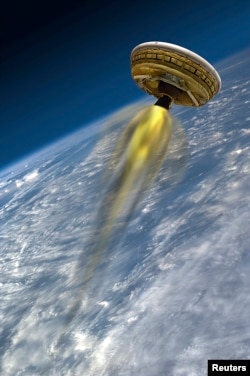The U.S. space agency's test run of a Mars landing system came to a disappointing end Monday when the saucer-shaped vehicle's parachute failed to unfurl high over the Pacific Ocean.
It was the second attempt by NASA engineers to test the new parachute system. A similar problem plagued the device's debut run last year. NASA hopes the concept will revolutionize planetary exploration.
After several weather related delays, the world's largest helium balloon was launched from a military base in Hawaii to test a saucer-like device called the Low-Density Supersonic Decelerator (LDSD). The LDSD is designed to investigate and test breakthrough technologies for landing robotic and human missions on Mars, and safely returning large payloads to Earth.
"This new technology is required to land five metric tons, for human missions, maybe 30 and beyond, metric tons on the surface. So, the parachute we're using today can improve performance for landing mass by 100 to 200 percent, and that's really critical for not only future enhanced robotic missions, but human exploration of Mars," said Steve Jurczyk of the NASA Space Technology Mission Directorate.
Scientists say the thin atmosphere around Mars requires especially strong parachutes for landing heavy and fast-moving spacecraft.
"As we started thinking about the next generation of more capable, more exciting, more bold missions to Mars, we started realizing that we didn't have the technologies in place to land them, and we had to start today, start developing those technologies. Things like inflatable drag devices, that we could inflate at the speed of sound," explained Ian Clark of NASA’s Jet Propulsion Laboratory.
The parachute tested Monday is 30 meters in diameter. A "flying saucer" it was carrying weighed more than 3,000 kilograms, about twice the weight of the kind of robotic rover spacecraft NASA can currently land on Mars.
Late Monday, a NASA spokeswoman said the test failed when the parachute deployed but did not inflate. A similar test in June of last year suffered the same fate.











